Jam Session & An Homage to Tate & Lyle
“This year, our plum trees have been working overtime. There are only two of them, thank God, but each has contributed hundreds of perfect, wine-red fruit, brushed with undertones of pale yellow. These ‘koromila,’ as they’re called in Greek, are the size of slightly flattened ping-pong balls. And they taste equally delicious by the handful or turned into jams, pies, chutneys, ‘clafoutis,’ sorbets, or something exotic I haven’t come up with yet.” Diana Farr Louis
Eating Well Is The Best Revenge
by Diana Farr Louis
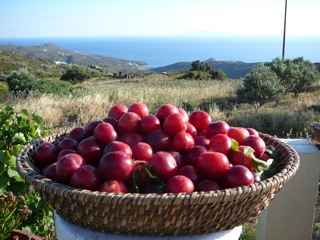
ANDROS Greece—(Weekly Hubris)—7/16/2012—This year, our plum trees have been working overtime.
There are only two of them, thank God, but each has contributed hundreds of perfect, wine-red fruit, brushed with undertones of pale yellow. These “koromila,” as they’re called in Greek, are the size of slightly flattened ping-pong balls. And they taste equally delicious by the handful or turned into jams, pies, chutneys, ‘clafoutis,’ sorbets, or something exotic I haven’t come up with yet. Plum tapenade, anyone?
Mercifully, they did not ripen simultaneously or my enthusiasm might have quailed by now. And friends have been most obliging. So I am still happy to stand at the kitchen sink, pitting them raw for the freezer or cooking them for immediate use. Squelching through a pot of cooled, softened plums, hands and forearms gloppy with juice and bits of fruit, is as satisfying as decorating a dribble-castle on the beach or patting oodles of mud pies.
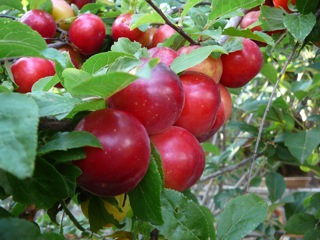
Plus I have the satisfaction of watching olive leaves shimmer in the breeze and butterflies flirt with the mauve flowers on our buddleia.
But I digress. Jam needs sugar and, as always, I’ve brought bags of Tate & Lyle jam sugar from Athens for the summer’s preserves. It has pectin added and so one needs only half the amount of both sugar and boiling for the jam to set.
But, this year, the bags come with a new slogan: “Tate & Lyle, Taste & Smile.” And so I do . . . thinking about sugar, and the Farr family, and my father’s connection with that venerable British firm (http://www.tateandlyle.com/Pages/default.aspx; http://en.wikipedia.org/wiki/Tate_%26_Lyle).
I had the original Sugar Daddy. My Pa, Francis Shelton Farr, was a sugar broker. After the First World War, he founded Farr and Company with an office on Wall Street, and he might have been happier there than at home, until his mid-70’s, when he was forced to retire. He loved his job with a passion and, sometimes tried to instruct us on the superiority of cane to beet sugar; of Cuban sugar over that of any other country. And every morning at 8 o’clock sharp, before he left the house to drive into the city, he’d receive a call from London about the market there.
I knew nothing about commodities transactions as a child, a condition that has barely changed in the years since. I had no idea about futures and market fluctuations, but greatly appreciated the end product: the life savers that lived in Dad’s pocket, the Hershey bars weighing a pound each he’d bring back from a visit to the factory in Pennsylvania, the ten-pound box of Whitman’s Sampler chocolates that would arrive each Christmas.
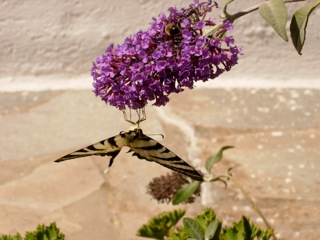
Most of all, I loved the box of pralines from New Orleans that also appeared at Christmas. It held eight of them, wrapped in individual envelopes, and we each had our own. I tried to make mine last and, never since, even in NOLA itself, have I ever found a praline that could compare with that superlative combination of melt-in-the-mouth sugar and glazed pecans.
Dad spoke in aphorisms, and one of the most common was, “A bit of sweet makes the meal complete.” Along with, “Doubtless God could have made a better berry; doubtless God never did,” which came out every time we had strawberries; and, “Never worry about the dealer or the carver,” a regular pronouncement when he sliced and served the Sunday roast. Among others.
Although we used to roll our eyes in despair every time we heard his sayings, all seven of us siblings have passed them on to our children and/or spouses. And, although my sweet tooth rarely makes excessive demands, I do harbor cravings for just one square of dark chocolate, or two (or three) pieces of crystallized ginger after a typically Greek, dessert-free lunch.
Besides talking to London every weekday, Dad’s main business partners were in Havana. In the spring of ’56, he took three of us middle children there with our mother. On my first trip to a foreign country, I was bowled over by the colors, smells, rhythms, noises and warmth—of the people as well as the tropical climate.
There I had my first daiquiri (at Sloppy Louie’s), played with my first slot machine, and won a bucketful of nickels, washed my feet in my first bidet, and had my first sublime plate of spit-roasted piglet. At a restaurant on Varadero Beach, with Batista’s gin palace anchored offshore. An omen?
That summer or perhaps it was the next, my father sent me off to England—to stay with dear friends from Tate & Lyle. Tony and Brenda W-S and their four children were just as welcoming as the Cubans, though I remember shivering next to the electric heater in Surrey in July. But we certainly never ate anything as spectacular as that piglet. Instead, we indulged in a daily parade of meals: copious breakfasts followed by Elevenses followed by lunch, then tea with sandwiches in the garden and, finally, supper.
During that month, I made my first acquaintance with a “fearsome zucchini”—a humongous marrow boiled to mush and awash in its own insipid juices. But my dear hosts also supplied such novelties as gooseberry fool, summer pudding with raspberries and black currants, and steak and kidney pie. And we worked up vast appetites playing tennis and watching a two-day cricket match at Lord’s—nothing like boredom to make you ravenous.
But giant squash and cricket aside, I adored being part of the family and returned to Long Island an ardent Anglophile, with what I thought was a British accent.
I did not see Tony and Brenda again until about ten years later when they came to New York. By then, my father’s firm was facing bankruptcy. Although Fidel had embraced the US at first and even used Farr & Co. as a base in New York, his revolution and the subsequent embargo on Cuban products slowly ravaged my father’s business. They tried to diversify, develop more contacts with other sugar sources, but the debts piled up.
On the eve of their visit, my father suffered the worst indignity. His partners, sons of the original co-founders, gave him two weeks’ notice. He would have to retire, and without a pension. Knowing I was to have lunch with Tony and Brenda the next day, he swore me to secrecy. I was on no account to reveal this humiliating turn of events.
I broke my promise and told them all; shared my fury at this shabby treatment of my 76-year-old father. They were horrified.
It may have been the best thing I ever did.
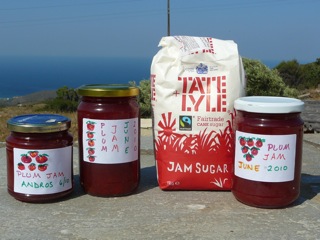
On their return to London, Tony arranged with his bosses for my father to receive a full pension from Tate & Lyle—in recognition of his decades of devoted and honorable association with them. It was an offer he couldn’t refuse and their generosity kept him and my mother comfortable for the rest of his life.
Tate & Lyle. Taste & Smile. I always do. Through my tears. Thank you, again.
![]()
Recipe
Plum Granita
A new excellent resource for food lovers is Edward Behr’s Art of Eating Cookbook, Essential Recipes from the First 25 Years**. I’ll be writing more about the book later but the other day I was looking for a recipe for granita that would be something more than crystallized fruit juice so hard you need an ice pick to eat it. And I found inspiration in his recipe for “slushy firm” Melon Ice. I think almost any fruit could be used.
¼ cup/50 g sugar
1 ½ cups/400 ml water
2 lb/1 kg plums, pitted (Behr used a 3 lb/1.5 kg melon)
½ cup/125 ml or more light, cold white or rose wine
Boil the sugar and water together, stirring to dissolve the sugar. Set the syrup aside to cool, and then chill it completely in the refrigerator.
Prepare the fruit. (If melon, you want 2 compressed cups/500 ml of flesh.) I think I had a bit more, wasn’t too precise. Puree the fruit in a blender or food processor. Combine the puree with the chilled sugar syrup and wine in a shallow bowl, and then chill deeply in the refrigerator, at least 1 hour, followed by 5 to 10 minutes in the freezer.
Break up the ice crystals thoroughly every 20 minutes or so (this will depend on your freezer/type of fruit) with a fork, until the liquid has turned into a firm slush of fine crystals. If you don’t serve the ice immediately, store it in the freezer. . . . About half an hour before you intend to serve it, take it out of the freezer and place it in the refrigerator to soften.
Makes about 1 quart/liter.
My plum granita was sublime, so much so that I’ve frozen bags and bagsful of pitted plums for future delectation.
**The Art of Eating Cookbook contains recipes from the first 25 years of Edward Behr’s beautiful quarterly magazine dedicated to wonderful, authentic foods and wines and the people who produce them. It was printed in 2011 by the University of California Press, Berkeley, Los Angeles/London.
![]()
Author’s Note: I first wrote this column exactly two years ago when the plum trees were again in munificent mode. And this year, they are keeping me so busy I thought you wouldn’t mind if I recycle the story—one of my favorites, in any case.
Publisher’s Note: Henry Tate established his business in 1869 in Liverpool, later expanding to Silvertown in the East of London: he used his industrial fortune to found the Tate Gallery in London in 1897.
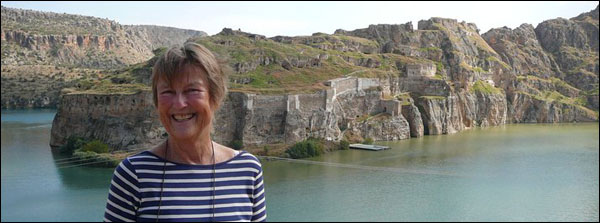

9 Comments
Anita Eveson-Peck
Lovely koromila waiting in the freezer! Thank you! xxxA
di
Wonderful – as always your reminiscences utterly captivate me.
My own eyes filled with tears on completing your final line….
thanks Diana
xxx
Carol Natsis
Diana, I love this story, even if it is the second time round. I wish I could be in Andros to sample your preserves and granita.
Louise Schimmel
Dear Diana – the Hubris sent me an e- with a list of recent articles. Only one piqued my interest – why am I not surprised that you wrote it?? Your story knocked me off my pins – had no idea where it was going and was shocked at the treatment your father received. But what a happy ending – made me tear up. Now, about those plums: we had a banner year too, little yellow ones, – do your fingers and nails turn a kind of rusty color when you work with the plums? Mine do! The skin cleans up after a day or so, but dull brown seems permanently etched in my fingernails. You have this problem?
diana
Carol, wish you could have been here to sample them. Next time — inshallah!
And Di, thanks for your lovely words. Must mine my memories for more stories now that the plums have been taken care of!
Anita mou — thanks for being there and all your support.
Love to you all, D.
barbara kalmoutis
Dear Diana, after I read your tales of preparing and cooking all those marvelous meals…I feel so full, I dont need to eat for the rest of the day….and when you write about your life, you make everyone feel that you are their FRIEND…beware of nuts heading towards your abode. Love Barbara
Gretchen
Diana, What a lovely remembrance! I work down the road from the docks where Tate & Lyle’s sugar would have come in to London. The next time I walk past their building, I shall think of you and your father.
diana
I’m overcome by all your comments. Really, they make me tear up. Barbara, if the nuts are anything like you, I can’t wait to feed them a full meal of fun and memories in my abode. Louise, I don’t stay plum stained for long, though now I have a semi-permanent tomatoey color and aroma about my fingers. And Gretchen, what a lovely surprise to find you on my page, instead of me on yours!
Love to you all and may your meals be cooked, served and eaten with kefi and agape. Leave the washing up to others.
Rika Benaki
Dear Diana,
Deeply touched and in full agreement with the beautiful things written above.
A friend was telling me last night she makes jelly from koromila. I would
love to know how, exactly, you deep freeze them.